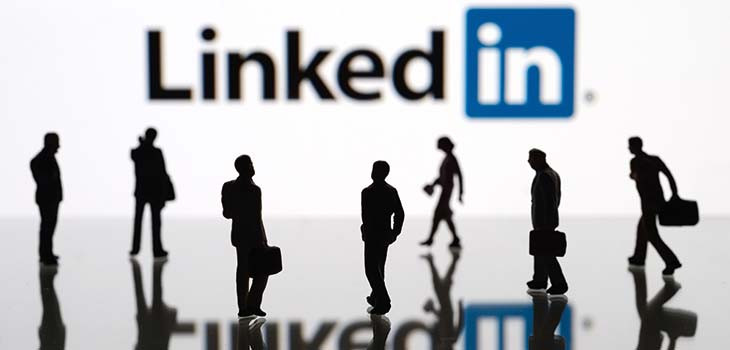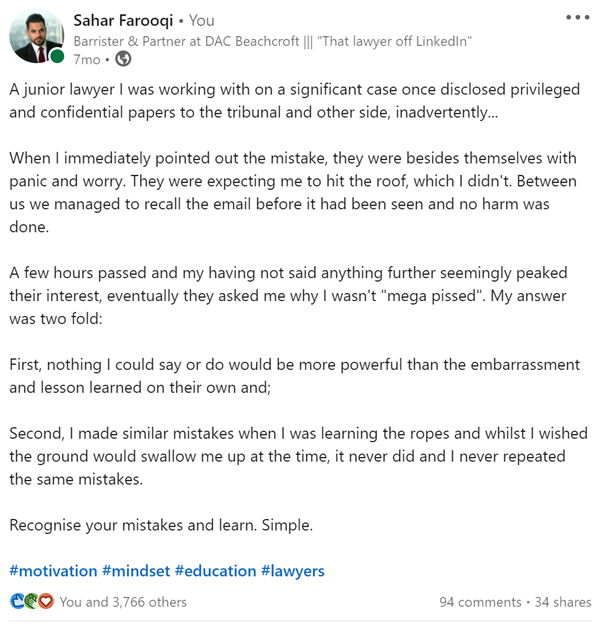*/

Lawyers, and barristers in particular, often feel slightly out of their comfort zone when it comes to business development, preferring their courtroom results and word of mouth to speak for them. Or, perhaps, to allow their clerking or marketing teams to handle ‘that side of things’. For many years it was even regarded as vulgar or uncouth to market oneself; indeed, barristers were actually prohibited from doing so for a long time.
But the world has moved on. The advent of social media, alongside multiple recessions and unprecedented global tumult since the clocks chimed for Y2K, have meant we have to move with the times. We have to recognise that it is incumbent upon us to build a reputation, network and – crucially – be seen. That being said, social media can be a scary place. Twitter, for example, has frequently landed people in trouble. As a platform where individuals can be broadly anonymous, it sometimes brings out the worst in people and the so-called ‘keyboard warriors’ or ‘trolls’, whose sole purpose is to be incendiary and to incite.
LinkedIn, however, is a different proposition; a dedicated social media platform for professionals to connect, engage, network and generally learn about their industry, amid a whole host of others as well. You will find existing clients, prospects and friends on the platform; people you know and people who you will come to know. Like almost anything in life, what you get out of it depends on what you are willing to put into it and – here’s the rub – how discerning you are with how you use it.
I have been using the platform in serious way for around five years now, during which time I have been able to recruit dozens of excellent people (including counsel), meet and engage new clients who have become friends and regular instructors, as well as offer some support to aspiring lawyers/students trying to navigate the early stages of their career. It has also led to me being offered various roles, speaking opportunities and industry awards. At the time of writing, I have a little over 37,000 followers on the platform who routinely engage with my regular and varied content. In light of this, I was approached by Counsel magazine to pen an article about my experience of using the platform, its utility and why purely ‘conventional’ posts tend to have less traction than something a little different.
The attention span of the average person thumbing through a feed of posts is incredibly limited. You have probably about five to eight seconds to get their attention, at best. Beyond that, they will simply scroll on and your message is lost. If you only use the platform to occasionally post something along the lines of ‘I am delighted to announce that…’, you will find yourself enjoying brief traction (people like a good news story) but nothing sustained. I have found that when I post something ‘cold’ about my work, my job or an aspect of the law the engagement is minimal. What you have to do is remember that your audience is human and they will engage with things that resonate. By analogy, if LinkedIn is a professional networking event, you need to have some conversation with strangers before you launch into a pitch, or else they won’t feel – pun very much intended – any connection to you.
‘So what works then, Sahar? Are you saying we need to click bait people?’ No, not at all, but you need to be relatable and accessible. The people you want to work with, or for, are people. They want to see a sense of you as a person; characteristics such as being interesting, vulnerability, openness, awareness, compassion and humour. These go a long way in breaking the ice. If you are seen as accessible and approachable, rather than aloof, you will begin to form organic conversations that lead you down a path which ends with more pointed conversations; typically, ‘How might you and I work together?’ Before it gets to that, though, you need to summon your experience of life and remember what all of us have experienced.
What happens when you engage with the reality of human existence, or the reality of being a professional, or a lawyer, is that people recognise what you are saying. They see themselves in you and they want to work with you. Why? Because it’s clear you get it; you get the journey and you’ve earned the same stripes as them. Beyond that, the conversation turns to normal things about credentials and experience, which you can present against the backdrop of a situation where they feel some connection to you.
I repeat the above. Beyond that, understand how the almighty algorithm works. The first few hours after you post something are critical. When people comment – respond. It isn’t rocket science. The more conversations going on around your post, the more the algorithm thinks ‘this is something people are engaging with, let’s push it into the feeds of others’. As traction builds, people from your industry or potential recruits, clients, start seeing your post. They then engage and this provokes both conversation and opportunity. What you then have to do is recognise the people engaging and ‘direct message’ them. Set up a meeting, be it virtual or otherwise. Capitalise on the fact that you are now in their consciousness; that they have indicated they ‘like’ what you have to say. Where you take the follow up and the meeting then depends on you. The opportunity stems from your ability to use the platform properly.
Fair enough. Very few people are. However, you can still find a space and a name by commenting and engaging with content from others. My posts are frequently viewed hundreds of thousands of times. If you comment and engage with it, a lot of people will see it. Whether that’s to express agreement or disagreement (so long as it is put in a respectful, reasoned way) is less important than the fact of your engagement. People will see it and they will react. In one sense, it is the easiest and most simple way to engage, without really having to put yourself out there.
LinkedIn is a marketing tool. It is digital professional networking. It is opportunity with minimal effort, if you deign to understand the potential. Part of the beauty, on a long enough time scale, is that people begin to approach you with referrals that you can’t handle personally, but you can direct to friends or colleagues. That, in itself, leads to those people sending you work later down the line. Not every conversation or post leads to what you might want and you may have to kiss a few frogs. Along the way, though, you will help students, dispel fictions about the Bar and gain engaged clients and followers who like what you have to say.
So, the point of using LinkedIn is to build and enhance your practice, career and engagement with the wider professional world of which you are a part. When you read that last sentence, it’s hard not to think it’s an easy win.


By analogy LinkedIn is a professional networking event; you need to have some conversation with strangers before you launch into a pitch.

Lawyers, and barristers in particular, often feel slightly out of their comfort zone when it comes to business development, preferring their courtroom results and word of mouth to speak for them. Or, perhaps, to allow their clerking or marketing teams to handle ‘that side of things’. For many years it was even regarded as vulgar or uncouth to market oneself; indeed, barristers were actually prohibited from doing so for a long time.
But the world has moved on. The advent of social media, alongside multiple recessions and unprecedented global tumult since the clocks chimed for Y2K, have meant we have to move with the times. We have to recognise that it is incumbent upon us to build a reputation, network and – crucially – be seen. That being said, social media can be a scary place. Twitter, for example, has frequently landed people in trouble. As a platform where individuals can be broadly anonymous, it sometimes brings out the worst in people and the so-called ‘keyboard warriors’ or ‘trolls’, whose sole purpose is to be incendiary and to incite.
LinkedIn, however, is a different proposition; a dedicated social media platform for professionals to connect, engage, network and generally learn about their industry, amid a whole host of others as well. You will find existing clients, prospects and friends on the platform; people you know and people who you will come to know. Like almost anything in life, what you get out of it depends on what you are willing to put into it and – here’s the rub – how discerning you are with how you use it.
I have been using the platform in serious way for around five years now, during which time I have been able to recruit dozens of excellent people (including counsel), meet and engage new clients who have become friends and regular instructors, as well as offer some support to aspiring lawyers/students trying to navigate the early stages of their career. It has also led to me being offered various roles, speaking opportunities and industry awards. At the time of writing, I have a little over 37,000 followers on the platform who routinely engage with my regular and varied content. In light of this, I was approached by Counsel magazine to pen an article about my experience of using the platform, its utility and why purely ‘conventional’ posts tend to have less traction than something a little different.
The attention span of the average person thumbing through a feed of posts is incredibly limited. You have probably about five to eight seconds to get their attention, at best. Beyond that, they will simply scroll on and your message is lost. If you only use the platform to occasionally post something along the lines of ‘I am delighted to announce that…’, you will find yourself enjoying brief traction (people like a good news story) but nothing sustained. I have found that when I post something ‘cold’ about my work, my job or an aspect of the law the engagement is minimal. What you have to do is remember that your audience is human and they will engage with things that resonate. By analogy, if LinkedIn is a professional networking event, you need to have some conversation with strangers before you launch into a pitch, or else they won’t feel – pun very much intended – any connection to you.
‘So what works then, Sahar? Are you saying we need to click bait people?’ No, not at all, but you need to be relatable and accessible. The people you want to work with, or for, are people. They want to see a sense of you as a person; characteristics such as being interesting, vulnerability, openness, awareness, compassion and humour. These go a long way in breaking the ice. If you are seen as accessible and approachable, rather than aloof, you will begin to form organic conversations that lead you down a path which ends with more pointed conversations; typically, ‘How might you and I work together?’ Before it gets to that, though, you need to summon your experience of life and remember what all of us have experienced.
What happens when you engage with the reality of human existence, or the reality of being a professional, or a lawyer, is that people recognise what you are saying. They see themselves in you and they want to work with you. Why? Because it’s clear you get it; you get the journey and you’ve earned the same stripes as them. Beyond that, the conversation turns to normal things about credentials and experience, which you can present against the backdrop of a situation where they feel some connection to you.
I repeat the above. Beyond that, understand how the almighty algorithm works. The first few hours after you post something are critical. When people comment – respond. It isn’t rocket science. The more conversations going on around your post, the more the algorithm thinks ‘this is something people are engaging with, let’s push it into the feeds of others’. As traction builds, people from your industry or potential recruits, clients, start seeing your post. They then engage and this provokes both conversation and opportunity. What you then have to do is recognise the people engaging and ‘direct message’ them. Set up a meeting, be it virtual or otherwise. Capitalise on the fact that you are now in their consciousness; that they have indicated they ‘like’ what you have to say. Where you take the follow up and the meeting then depends on you. The opportunity stems from your ability to use the platform properly.
Fair enough. Very few people are. However, you can still find a space and a name by commenting and engaging with content from others. My posts are frequently viewed hundreds of thousands of times. If you comment and engage with it, a lot of people will see it. Whether that’s to express agreement or disagreement (so long as it is put in a respectful, reasoned way) is less important than the fact of your engagement. People will see it and they will react. In one sense, it is the easiest and most simple way to engage, without really having to put yourself out there.
LinkedIn is a marketing tool. It is digital professional networking. It is opportunity with minimal effort, if you deign to understand the potential. Part of the beauty, on a long enough time scale, is that people begin to approach you with referrals that you can’t handle personally, but you can direct to friends or colleagues. That, in itself, leads to those people sending you work later down the line. Not every conversation or post leads to what you might want and you may have to kiss a few frogs. Along the way, though, you will help students, dispel fictions about the Bar and gain engaged clients and followers who like what you have to say.
So, the point of using LinkedIn is to build and enhance your practice, career and engagement with the wider professional world of which you are a part. When you read that last sentence, it’s hard not to think it’s an easy win.


By analogy LinkedIn is a professional networking event; you need to have some conversation with strangers before you launch into a pitch.


Chair of the Bar reflects on 2025
Q&A with criminal barrister Nick Murphy, who moved to New Park Court Chambers on the North Eastern Circuit in search of a better work-life balance
Revolt Cycling in Holborn, London’s first sustainable fitness studio, invites barristers to join the revolution – turning pedal power into clean energy
Rachel Davenport, Co-founder and Director at AlphaBiolabs, reflects on how the company’s Giving Back ethos continues to make a difference to communities across the UK
By Marie Law, Director of Toxicology at AlphaBiolabs
AlphaBiolabs has made a £500 donation to Sean’s Place, a men’s mental health charity based in Sefton, as part of its ongoing Giving Back initiative
Professor Dominic Regan and Seán Jones KC present their best buys for this holiday season
Little has changed since Burns v Burns . Cohabiting couples deserve better than to be left on the blasted heath with the existing witch’s brew for another four decades, argues Christopher Stirling
Six months of court observation at the Old Bailey: APPEAL’s Dr Nisha Waller and Tehreem Sultan report their findings on prosecution practices under joint enterprise
Despite its prevalence, autism spectrum disorder remains poorly understood in the criminal justice system. Does Alex Henry’s joint enterprise conviction expose the need to audit prisons? asks Dr Felicity Gerry KC
With automation now deeply embedded in the Department for Work Pensions, Alexander McColl and Alexa Thompson review what we know, what we don’t and avenues for legal challenge